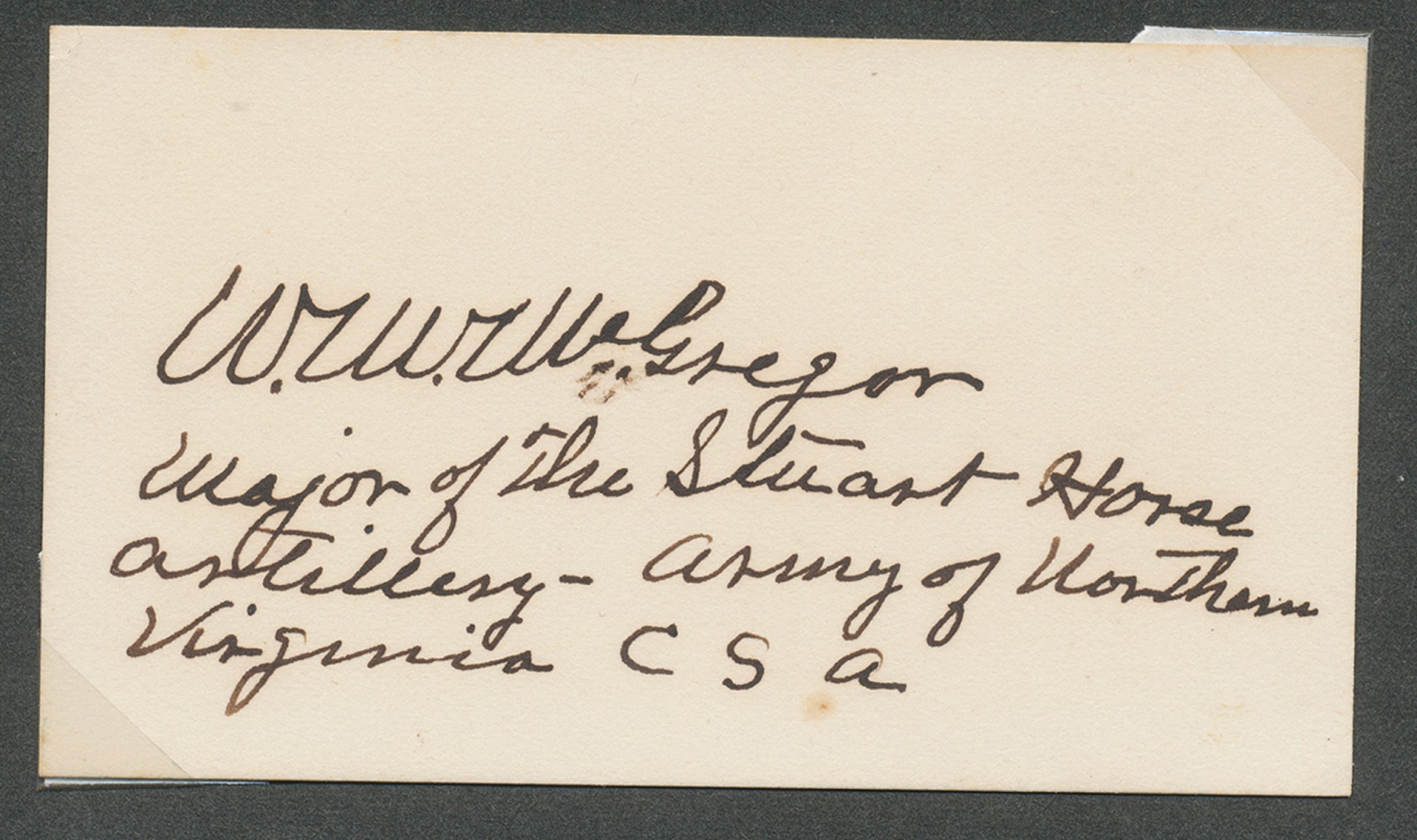site search
online catalog
SIGNATURE – WILLIAM MORRELL MCGREGOR, 2ND STUART HORSE LIGHT ARTILLERY BATTERY

$65.00 SOLD
Quantity Available: None
Item Code: 337-263
Dark ink signature on 3 3/8” x 2” card. “W.W. McGregor / Major of The Stuart Horse / artillery – Army of Northern / Virginia C S A”. Excellent condition.
On 6/4/61 at the age of 21, William Morrell McGregor, a lawyer from Talladega, AL, enlisted as a private and served with Co. E, 10th Alabama Infantry until transferred to J.E.B. Stuart’s Horse Artillery on 12/20/61. At that time and early in 1862, the Horse Artillery was in the Cavalry Brigade, Reserve Division under G.W. Smith in T.J. Jackson’s command. It was called simply, Stuart Horse Artillery, with 6 guns commanded by Capt. John Pelham. In April 1862 the unit was detached from the Reserve Artillery and placed in its own category at Stuart’s Cavalry Brigade, called Pelham’s Horse Battery; it listed 8 guns and 1,289 men. This was the first in a series of organizational changes which continued through the war. By 1862 there were 2 batteries in the brigade, Stuart’s Horse Artillery commanded by Pelham and Chew’s Battery commanded by Capt. R. Preston Chew. In November, the dashing cavalry chieftain had five batteries, and after some shuffling of commanders, the name McGregor appeared in charge of the new 2nd Stuart Horse Artillery.
From this period to War's end, McGregor retained command of the 2nd until he was given his own battalion. A Biographical sketch stated "because of his gallantry and courage noted by his officers, promotion speedily followed." He moved through the ranks, ultimately becoming major. In March, 1865 final reorganization resulted in five artillery battalions; McGregor was given command of the second, consisting of two batteries which with, it is believed, three three-inch guns.
Thus, William McGregor, in less than four years, rose from private to major commanding an artillery battalion-a decimated battalion, but a battalion nonetheless. He fought in all major and most minor engagements involving Stuart's artillery. Doubtless, the toll on Confederate artillerymen had much to do with his meteoric rise. But, while not as flamboyant as Pelham or Pegram, he evinced skill and courage to match them-and a measure of luck, too.
While he received wounds causing him to limp for the rest of his life, he was still full of fight when Lee surrendered. Parole lists at Appomattox do not include any of McGregor's command; it is believed he joined General Johnston with a large detachment of horse artillery under Col. Chew who escaped with Rosser's Cavalry Division and reported to Greensboro, North Carolina April 30, 1865. however, the unit was not permitted to engage in hostilities against Sherman for it was felt it was an integral part of Lee's army and, therefore, considered surrendered. McGregor's unit was later paroled with Johnston's troops.
McGregor moved to Texas from Alabama after the war; he died in Cameron, TX in 1908. Following the war he practiced law, and founded a newspaper. He is buried in Cameron.
~~~~~~~~~~~~~~~~~~~~~~~~~~~~~~~~~~~
THIS ITEM, AS WITH ALL OTHER ITEMS AVAILABLE ON OUR WEB SITE,
MAY BE PURCHASED THROUGH OUR LAYAWAY PROGRAM.
FOR OUR POLICIES AND TERMS,
CLICK ON ‘CONTACT US’ AT THE TOP OF ANY PAGE ON THE SITE,
THEN ON ‘LAYAWAY POLICY’.
THANK YOU!
Inquire About SIGNATURE – WILLIAM MORRELL MCGREGOR, 2ND STUART HORSE LIGHT ARTILLERY BATTERY
For inquiries, please email us at [email protected]
Most Popular
Historical Firearms Stolen From The National Civil War Museum In Harrisburg, Pa »
Theft From Gravesite Of Gen. John Reynolds »
Cavalry Carbine Sling Swivel »
Fine Condition Brass Infantry Bugle Insignia »
featured item
VERY SCARCE CIVIL WAR BROGANS
Officially referred to as army bootees, collectors most often know them as brogans, a term used at the time, though soldiers mostly called them just shoes. They were produced in a number of variations, with both sewn and pegged soles, made by hand… (149-42). Learn More »



